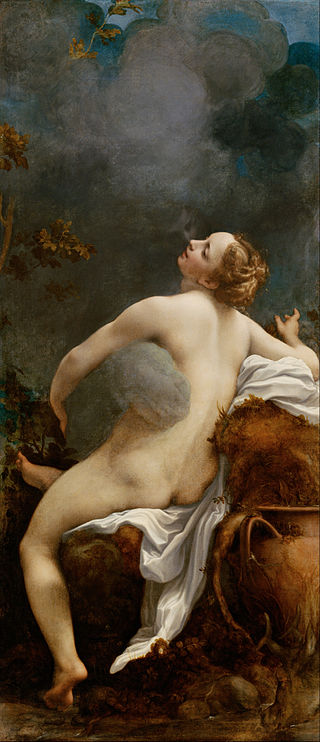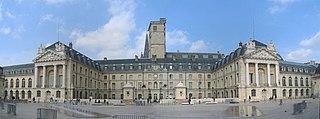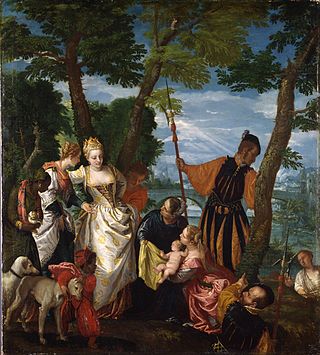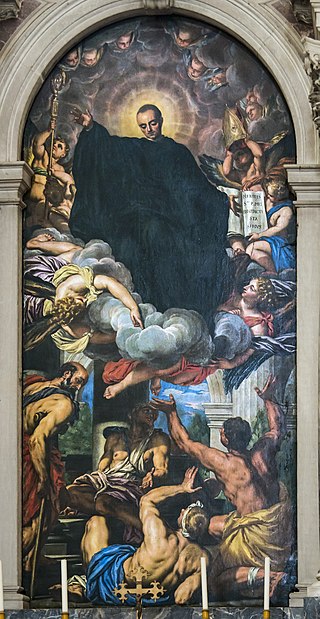
Paolo Caliari, known as Paolo Veronese, was an Italian Renaissance painter based in Venice, known for extremely large history paintings of religion and mythology, such as The Wedding at Cana (1563) and The Feast in the House of Levi (1573). Included with Titian, a generation older, and Tintoretto, a decade senior, Veronese is one of the "great trio that dominated Venetian painting of the cinquecento" and the Late Renaissance in the 16th century. Known as a supreme colorist, and after an early period with Mannerism, Paolo Veronese developed a naturalist style of painting, influenced by Titian.

Benedetto Caliari (1538–1598) was an Italian painter who was born into a family of artists. Benedetto's father Gabriele Caliari was a stonecutter. Benedetto's brother Paolo Caliari was the renowned painter Veronese.

The Orleans Collection was a very important collection of over 500 paintings formed by Philippe II, Duke of Orléans, mostly acquired between about 1700 and his death in 1723. Apart from the great royal-become-national collections of Europe it is arguably the greatest private collection of Western art, especially Italian, ever assembled, and probably the most famous, helped by the fact that most of the collection has been accessible to the public since it was formed, whether in Paris, or subsequently in London, Edinburgh and elsewhere.

The Musée des Beaux-Arts de Dijon is a museum of fine arts opened in 1787, in Dijon, France. It is one of the main and oldest museums of France. It is located in the historic city centre of Dijon and housed in the former ducal palace which was the headquarters of the Burgundy State in the 15th century. When the duchy was assimilated to the Kingdom of France, the palace became the house of the King. In the 17th century, it became the Palace of the Dukes of Burgundy following a project by Jules Hardouin-Mansart.

The Giorgio Cini Foundation, or just the Cini Foundation, is a cultural foundation founded by industrialist and politician Vittorio Cini in 20 April 1951 in memory of Giorgio Cini, his son who died in a airplane accident near Cannes in August 1949.

Ettore Tito was an Italian artist particularly known for his paintings of contemporary life and landscapes in Venice and the surrounding region. He trained at the Accademia di Belle Arti in Venice and from 1894 to 1927 was the Professor of Painting there. Tito exhibited widely and was awarded the Grand Prize in painting at the 1915 Panama–Pacific International Exposition in San Francisco. In 1926 he was made a member of the Royal Academy of Italy. Tito was born in Castellammare di Stabia in the province of Naples and died in Venice, the city which was his home for most of his life.

Michele Cascella was an Italian artist. Primarily known for his oil paintings and watercolours, he also worked in ceramics, lithography, and textiles. He exhibited regularly at the Venice Biennale from 1924 until 1942, and his works are owned by major museums in Italy and Europe, including Victoria and Albert Museum in London, Galerie nationale du Jeu de Paume in Paris, and Galleria Nazionale d'Arte Moderna in Rome.

Daniele Ranzoni was an Italian painter of second half of the 19th century.

The"' Finding of Moses'", sometimes called "'Moses in the Bulrushes'", "'Moses Saved from the Waters'", or other variants, is the story in chapter 2 of the Book of Exodus in the Hebrew Bible of the finding in the River Nile of Moses as a baby by the daughter of Pharaoh. The story became a common subject in art, especially from the Renaissance onwards.

Venus and Mars is an oil painting on canvas painted in the 1570s by the Italian Renaissance artist Paolo Veronese.
The Finding of Moses refers to several paintings of the Finding of Moses by Paolo Veronese and his studio. These include:

The Finding of Moses is a c.1581 oil-on-canvas painting by Paolo Veronese. It is the smallest of at least eight works on the subject by him and his studio showing the finding of Moses – art historians often consider it to be the preparatory sketch for the variant in Dresden.

The Pra della Valle in Padua is a 1741-1746 oil on canvas painting of the Prato della Valle in Padua by Canaletto. It entered the collection of the Milanese nobleman Gian Giacomo Poldi Pezzoli and from there it passed its present owner, the Museo Poldi Pezzoli in Milan.
Luigi Pericle Giovannetti, also known as Luigi Pericle, was a Swiss painter and illustrator of Italian origin.

The Finding of Moses is an oil-on-canvas painting by Paolo Veronese, from c. 1581-1582. It is held now in the Gemäldegalerie Alte Meister, in Dresden and measures 178 by 277 cm. It is one of at least eight works on the finding of Moses by Veronese and his studio – another now in Lyon is thought to be the preparatory sketch for the Dresden work.

The Finding of Moses is a now-lost oil on canvas painting of the finding of Moses by Paolo Veronese, once in the collection of Joseph Smith and one of at least eight works on the subject by the painter and his studio.

The Finding of Moses is a 1580 oil-on-canvas painting by Paolo Veronese of the finding of Moses, which has been in the Musee des Beaux Arts de Dijon since 1812. Its attribution to Veronese is early, with Lépicié stating it was "painted by the artist at the height of his powers", though Louis Clément de Ris argued it was a copy in 1861. It is now thought to be largely autograph with studio assistance as argued by Florence Ingersoll-Smouse in 1928, Bernard Berenson in 1932 and 1936 and Giuseppe Fiocco in 1934.
Evelyn Sandberg-Vavalà, also known by her married name as Evelyn Kendrew, was a British art historian who studied iconography in the Italian Renaissance.
Luisa Vertova was an Italian art historian. Her research work mostly focused on Renaissance Italian painters such as Piero della Francesca, Mantegna, Paolo Veronese, Titian, Botticelli and Caravaggio. In addition, she undertook numerous projects as editor of several editions of her mentor Bernard Berenson's and her husband Benedict Nicolson's writings.

Valentin Lefebre (1637–1677) was a Flemish painter, draughtsman and printmaker.
















